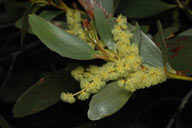In Flower This Week
A weekly news sheet prepared by a Gardens' volunteer.
Numbers before each plant refer to temporary IFTW labels in the gardens.
Numbers in square brackets [ ] refer to garden bed Sections. Plants in flower are in bold type.
View past issues of 'In Flower This Week'.
20 August 2014
Acacia phlebophylla click for larger image |
Let us concentrate on our wonderful wattles today.
- Walk along the path from the VIC to see on your right Acacia gordonii [Section 174], a small neat bush with bright gold balls of flowers. In the wild this plant is restricted to north-west of Sydney and is considered endangered.
- Acacia myrtifolia [Section 174], further along on your right, is an interesting and unusual wattle that has bright red new growth and stems with green elliptical phyllodes and cream balls of flowers. It is often called the Red-stemmed Wattle or Myrtle Wattle. It is found in all six Australian states.
- Turn up the road to your left behind the café and then turn right towards the Eucalypt Lawn. Acacia filicifolia [Section 2] or Fern-leaf Wattle], on your left, has dark green ferny foliage and masses of bright yellow balls of flowers. It occurs naturally in southern Queensland and New South Wales.
- Also on your left hand side is Acacia kybeanensis [Section 2], a medium shrub with grey-green foliage and yellow balls of flowers. It is found in the wild in New South Wales and Victoria.
- Acacia ‘Purpurea’ [Section 3], on your left, has many sprays of golden flowers with striking silver-grey fringed foliage with a feathery texture. This showy form of Acacia baileyana is very fast-growing and tough.
- Acacia amoena [Section 3], or Boomerang Wattle, on your left, is a small bush with tough yellow-green leaves and golden balls of flowers. It is native to New South Wales and northern Victorian tablelands.
- On your left behind the previous plant is Acacia phlebophylla [Section 3]. Also known as Buffalo Sallow Wattle or Mountain Buffalo Wattle, it is a straggling shrub to small, twisted tree reaching up to 5 m in height. It has large flat phyllodes and deep yellow rod-like flower heads. It is found in the wild only on the Buffalo Range in Victoria.
- In front of the previous plant is Acacia colletioides [Section 3], a very prickly sprawling shrub with fine linear foliage and small golden balls of flowers. It is endemic to Western Australia.
- Acacia covenyi [Section 3], commonly known as Blue Bush, up the road on your left has magnificent silver grey foliage and masses of contrasting bright gold flower balls. It is a rare plant in the wild and is confined to southern New South Wales.
- Acacia ingramii [Section 3] on your left is a large bush or small tree with fine linear foliage and masses of gold flower balls. It grows in the wild near Armidale in northern New South Wales.
- Acacia guinetii [Section 18], or Golden Gravel Wattle, on your left, has a compact shape and soft grey-green foliage with many gold flower balls. This plant grows naturally in Western Australia.
- Acacia cardiophylla [Section 18], or West Wyalong Wattle, on your left, has ferny light green bipinnate foliage and masses of yellow balls of flowers. It occurs in the wild in central and southern New South Wales.
- Acacia meiantha [Section 18] on your left, is a small straggling shrub with very fine needle foliage and masses of small yellow flower balls. It is threatened in the wild and occurs in a small area of central New South Wales.
- Acacia aphylla [Section 18], or Leafless Rock Wattle, on the left, has large gold balls of flowers on leathery leafless stems. It grows naturally around Perth, Western Australia.
- Acacia brunioides subsp. brunioides [Section 18] or Brown Wattle on your left is a small light bush with cream balls of flowers on bright green foliage. It occurs in the wild in northern New South Wales and southern Queensland.
Rosalind Walcott
![Director of National Parks [logo]](../../../../images/dnp_90px.gif)







